- Car finance Car finance
- Motorbike finance Motorbike finance
- Van finance Van finance
- How it works How it works
- FAQs and guides FAQs and guides
- About us About us
- Home
- Blog
- Latest Motor News
- Luckiest Learner Locations
Luckiest Learner Locations
Updated: Thursday, 8 February 2024
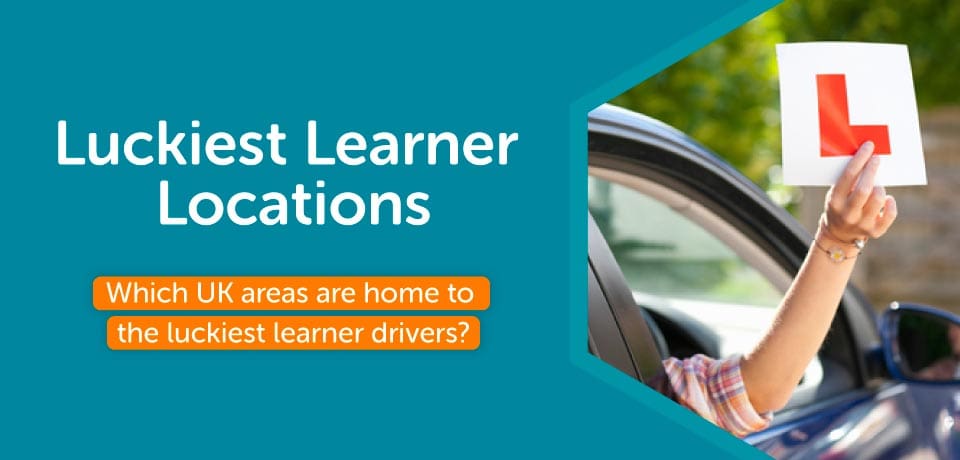
Which UK areas are home to the luckiest learner drivers?
There is a lot to think about when it comes to driving, from taking driving lessons to applying for car finance to help with the cost of purchasing your vehicle. Despite having so much to consider, the allure of driving a car makes us eager to get behind the wheel.
Recent figures estimate that more than 1.6 million Brits have taken a practical test in the last financial year alone, but how many of these have resulted in a pass? Using government data, we will reveal where drivers achieved the highest pass rate in the UK and how pass rates have changed over the past decade.
In addition, we’ll look at the age groups with the highest pass rate and the current average wait times to take your driving test across the country. To provide you with all the information you need for the big day, we will also share the most common driving faults before providing some expert tips on how to best prepare for your test.
How has the UK practical pass rate changed in the last decade?
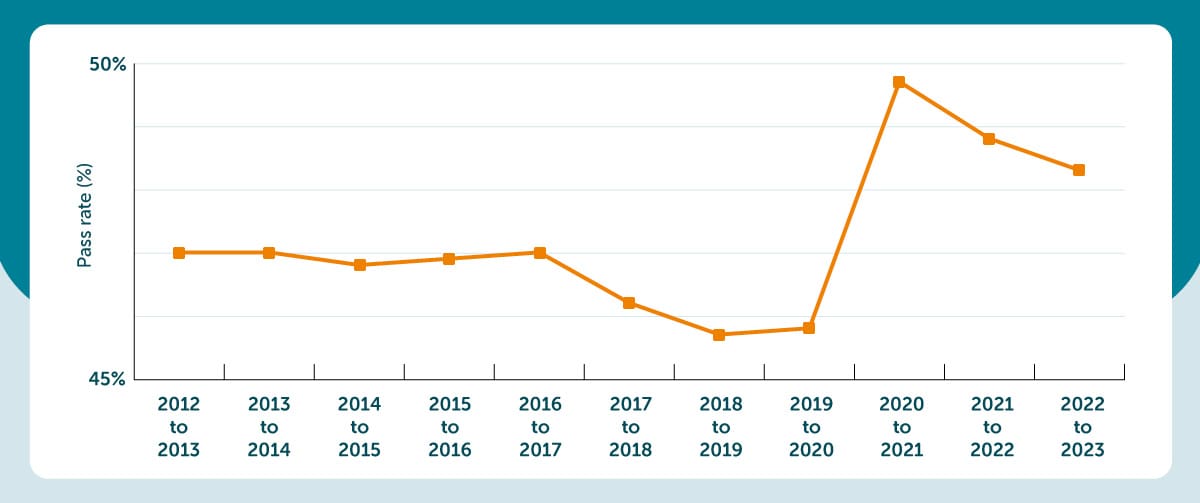
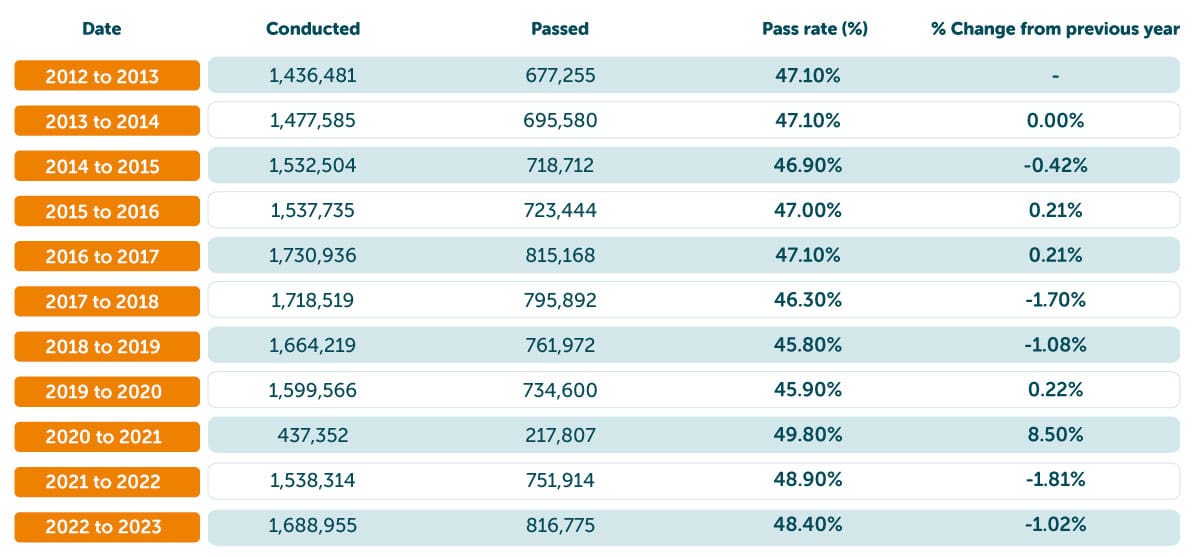
The number of conducted driving tests peaked in the 2016/17 financial year when more than 1.73 million drivers were tested on the roads. However, the highest annual passes occurred in the 2022/23 year, where 816,775 successful practical tests were recorded.
Due to the COVID-19 pandemic and resulting lockdown measures, fewer people took a driving test in 2020/21. Those who did take a test saw a practical pass rate of almost 50% – an 8.50% increase from the previous year and higher than any other pass rate in the last decade.
Since 2020, the pass rate has stayed consistently higher than pre-COVID. However, it is experiencing a slow decline year-on-year, decreasing by -1.02% between 2021/22 and 2022/23.
How has the UK theory pass rate changed in the last decade?
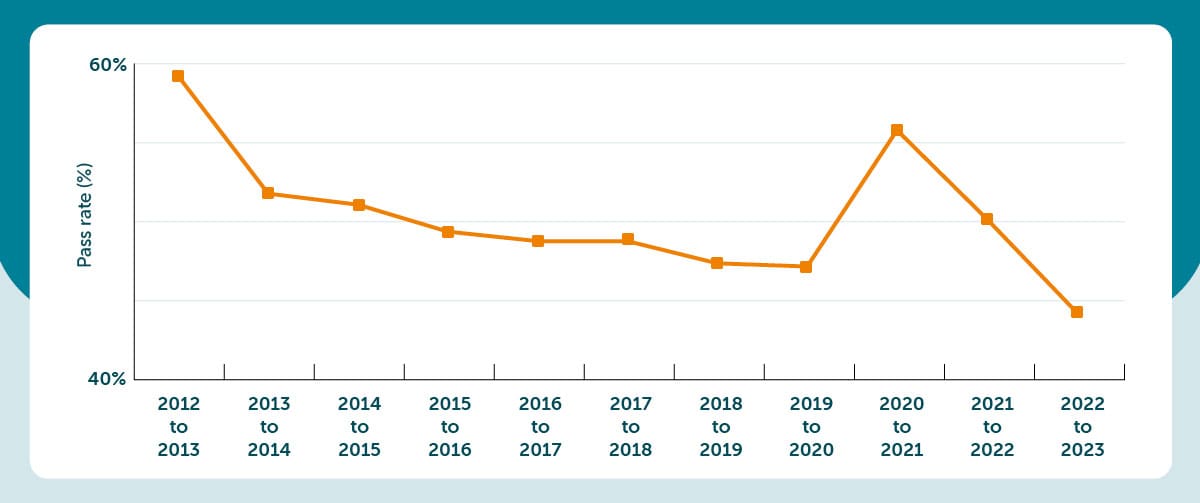
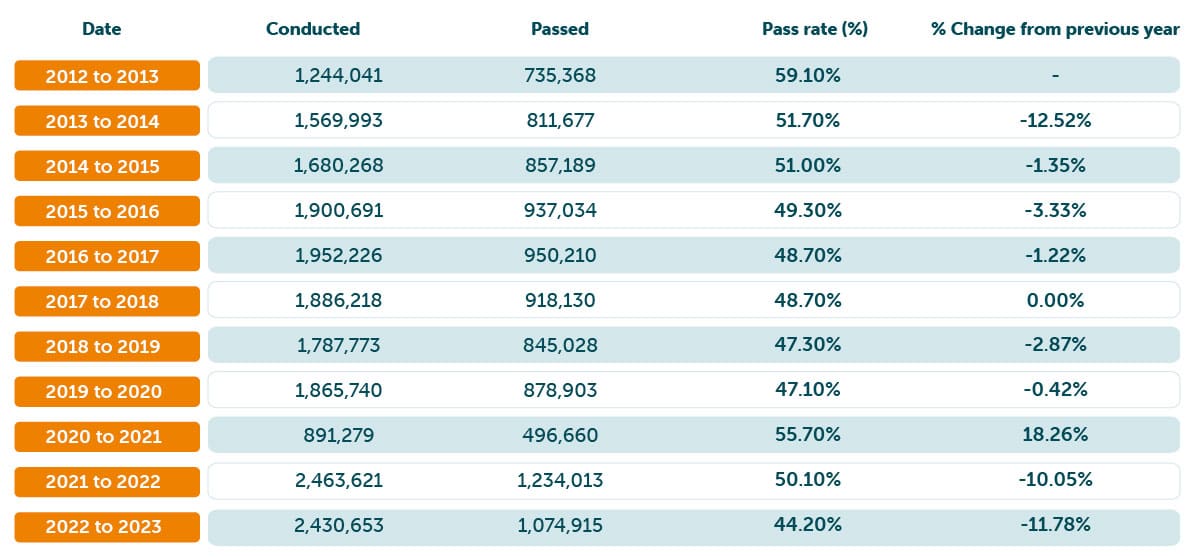
This time 10 years ago, theory test takers had a pass rate of nearly 60%. Fast forward to the 2022/23 financial year, and this number has dropped to 44.20%, a significant decrease in pass rates.
Figures indicate that more UK residents are progressing in their driving than ever, as the number of conducted theory tests has nearly doubled in the last decade – from just over 1.2 million in 2012/13 to more than 2.4 million in the 2022/23 financial year. The theory test pass rate has taken a hit recently, with an 11.78% decrease between 2021/22 and 2022/23.
How has the first-time pass rate changed in the last decade?
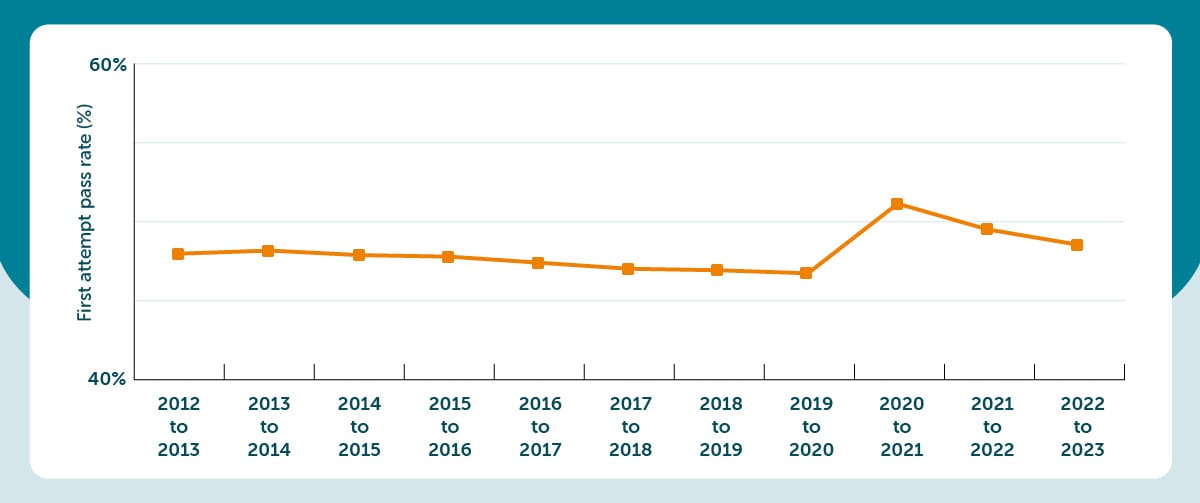
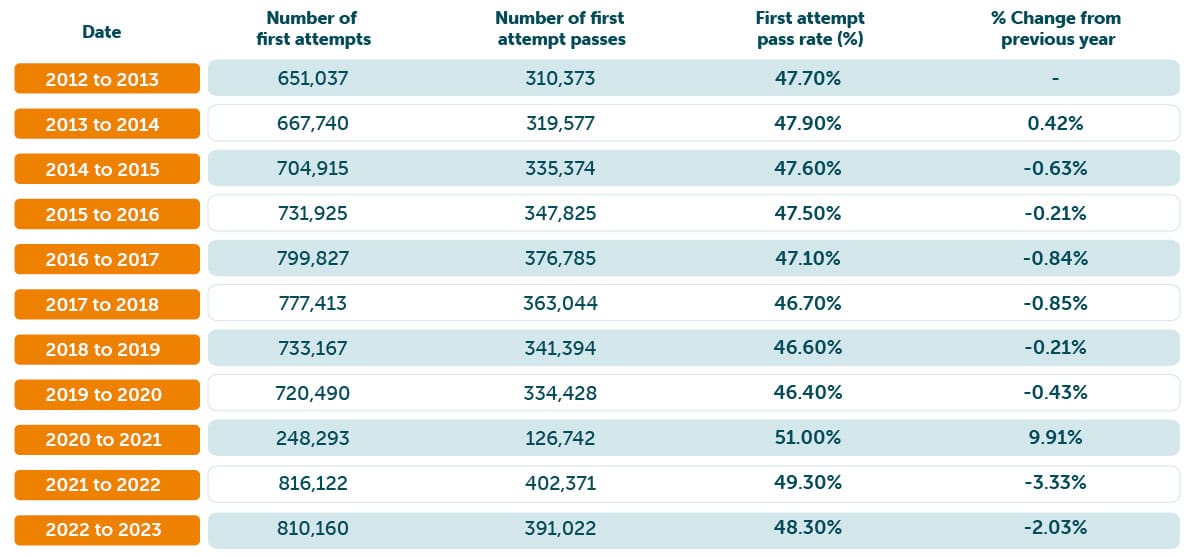
Recent years have seen an increase in the quality and quantity of first-time practical driving tests. 2021/22 saw the highest recorded number of first – attempts with one of the highest first-attempt pass rates, totalling 816,122 and 49.3%, respectively.
On the other hand, the lowest performing year in terms of the rate of first-attempt passes was the 2019/20 financial year, which saw a pass rate of just 46.40% out of the 720,490 tests completed – this was 0.21% lower than the previous year.
UK driving test centres with the highest practical pass rate
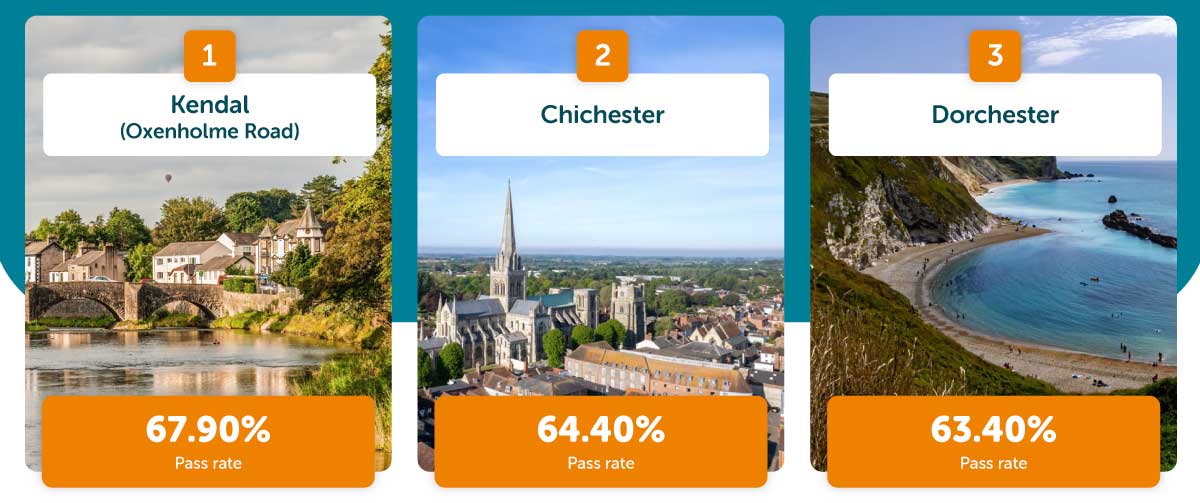

- Kendal (Oxenholme Road): 67.90% pass rate
According to recent data, the Kendal (Oxenholme Road) test centre is the most successful when it comes to passing your practical driving test. Located in Cumbria, this test centre has a pass rate of almost 68%, the highest of any area on our list.
- Chichester: 64.40% pass rate
Boasting a pass rate of 64.4%, Chichester is revealed as having the second-highest practical driving pass rate. Furthermore, this test centre has more passes than any other entry in our top three, totalling 2,361 between April 2023 and September 2023.
- Dorchester: 63.40% pass rate
Trailing just behind Chichester in the ranking is Dorchester. Of the 2,305 tests taken here between April 2023 and September 2023, almost two-thirds have resulted in a pass, which is among the highest pass rates of every test centre on our list.
UK driving test centres with the lowest practical pass rate
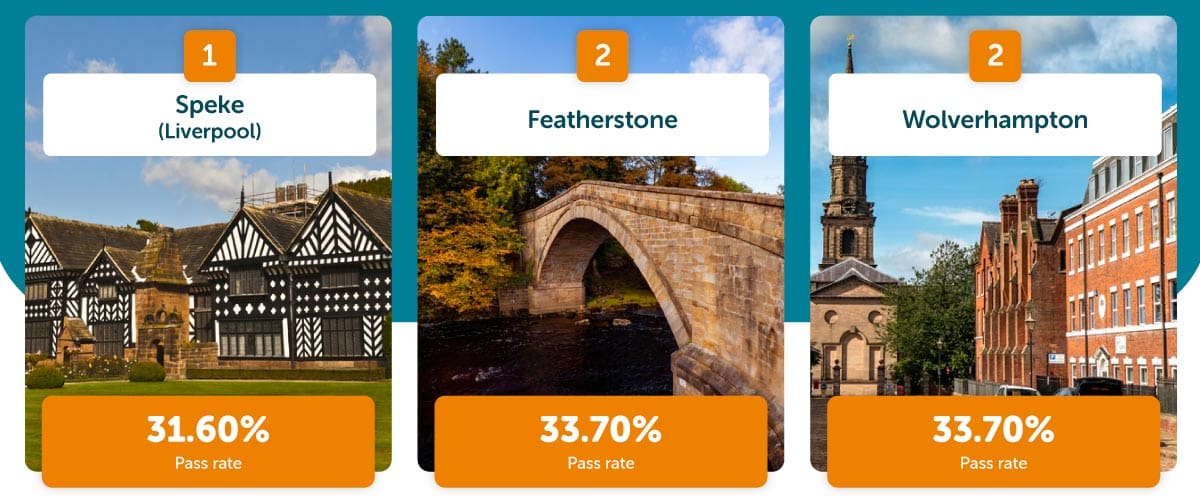
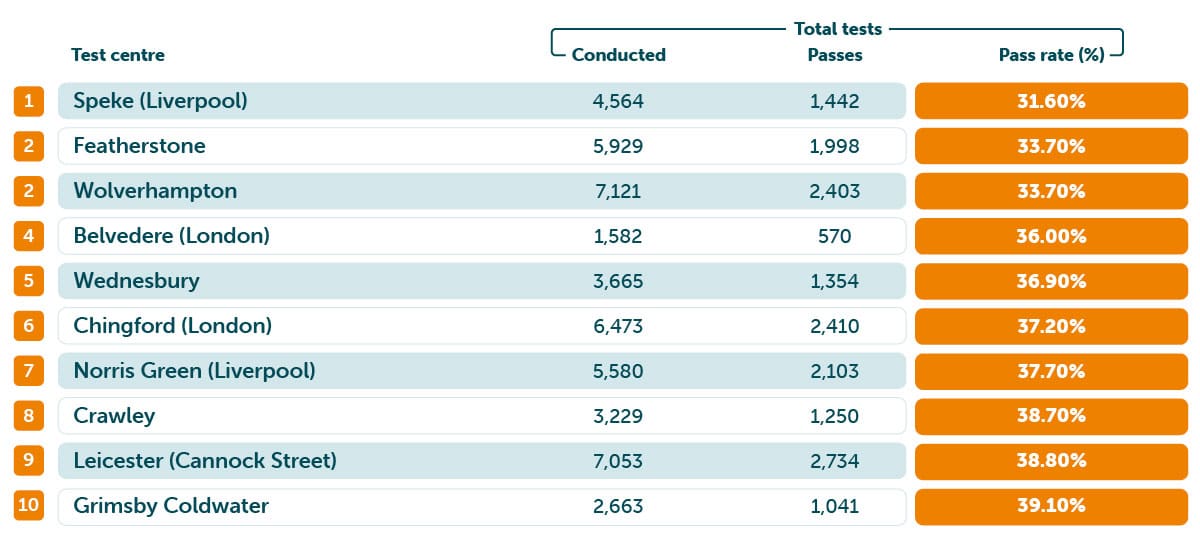
- Speke (Liverpool): 31.60% pass rate
Speke is the closest test centre for those learning to drive in South Liverpool. Unfortunately, this is also home to the lowest practical pass rate, which stands at 31.6% as of September 2023 – this is quite a way off the 48.8% national average.
- Featherstone and Wolverhampton: 33.70% pass rate
Featherstone and Wolverhampton driving test centres have a practical pass rate of 33.7%, the joint second-lowest pass rate of every entry on our list. Featherstone’s test centre has seen nearly 500 fewer passes compared to Wolverhampton.
- Belvedere (London): 36% pass rate
Completing the top three list of UK test centres with the lowest practical driving pass rate is Belvedere (London). London is known for its busy roads all year round, so it may be unsurprising that only 36% of driving tests here have been passed.
Which ages have the highest practical driving pass rate?
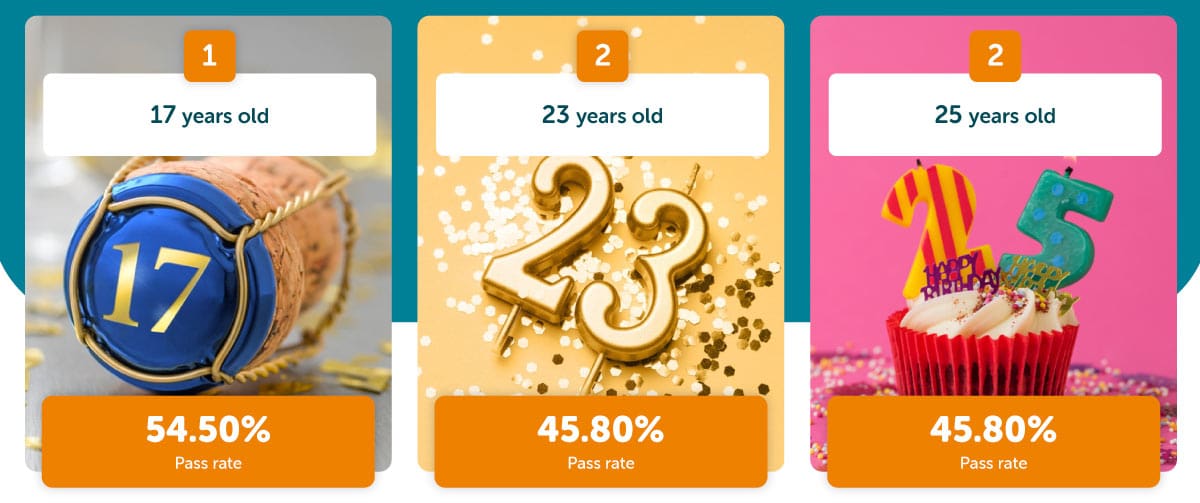
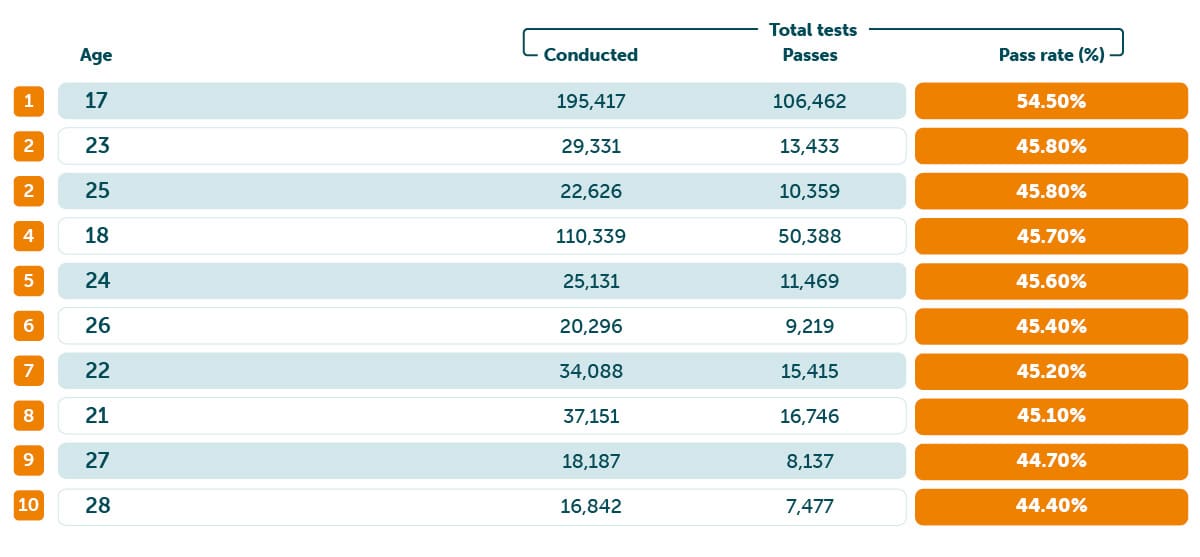
- 17 years old: 54.5% pass rate
In the UK, you can start driving a car at 17, and it is common for many teenagers to start driving lessons as soon as they turn this age. With this in mind, it may come as no surprise that 17-year-olds have the highest number of conducted tests on our list. In addition to this, they also have a better pass rate than any other age group, at 54.5%.
- 23 and 25 years old: 45.8% pass rate
The practical pass rate for both 23-year-olds and 25-year-olds is 45.8%, the joint second-highest of any age. Despite having the same pass rate, these two age groups differ quite a lot in the number of people taking tests, totalling 29,331 and 22,626, respectively.
- 18 years old: 45.7% pass rate
Our study found that 18-year-olds have the third highest practical driving pass rate of any age group, totalling 45.7%. This pass rate is based on the annual total of more than 110,000 tests conducted, in which over 50,000 drivers successfully earned their licence.
What are the most common driving faults?
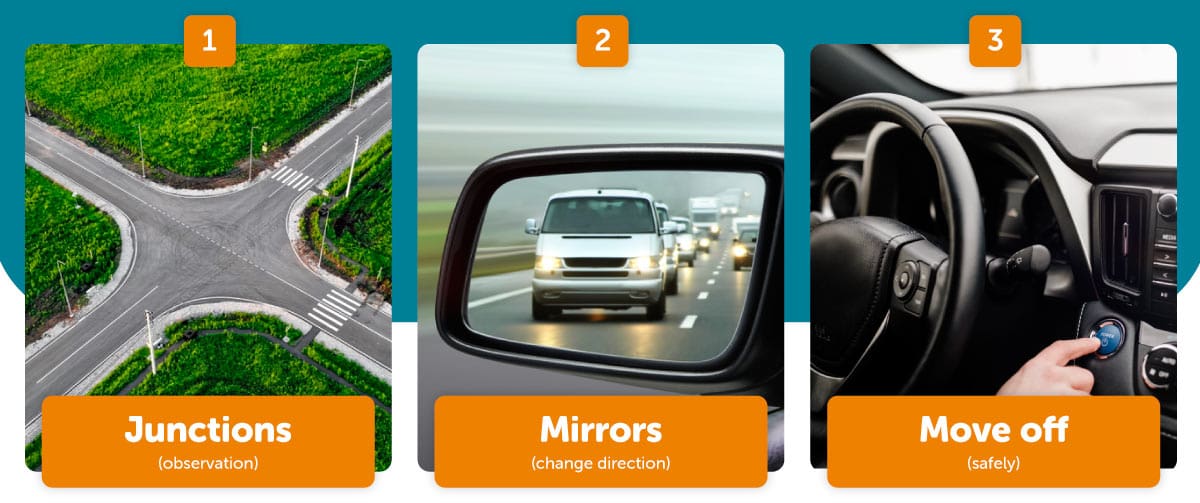
Our study found the top 10 most common driving faults:
- Junctions (observation)
- Mirrors (changing direction)
- Move off (safely)
- Junctions (turning right)
- Control (steering)
- Response to signals (traffic lights)
- Response to signals (traffic signs)
- Positioning (normal driving)
- Response to signals (road markings)
- Reverse park (control)
With so many things to consider during your driving test, it is common for people to make minor mistakes. Of all the possible faults, the most common is inability to make correct observations at junctions. This is followed by a failure to check mirrors when changing direction and moving off safely.
On the other hand, some faults catching people out less frequently include response to signals (road markings) and the ability to control the car during a reverse park.
The UK driving test centres with the longest average wait time
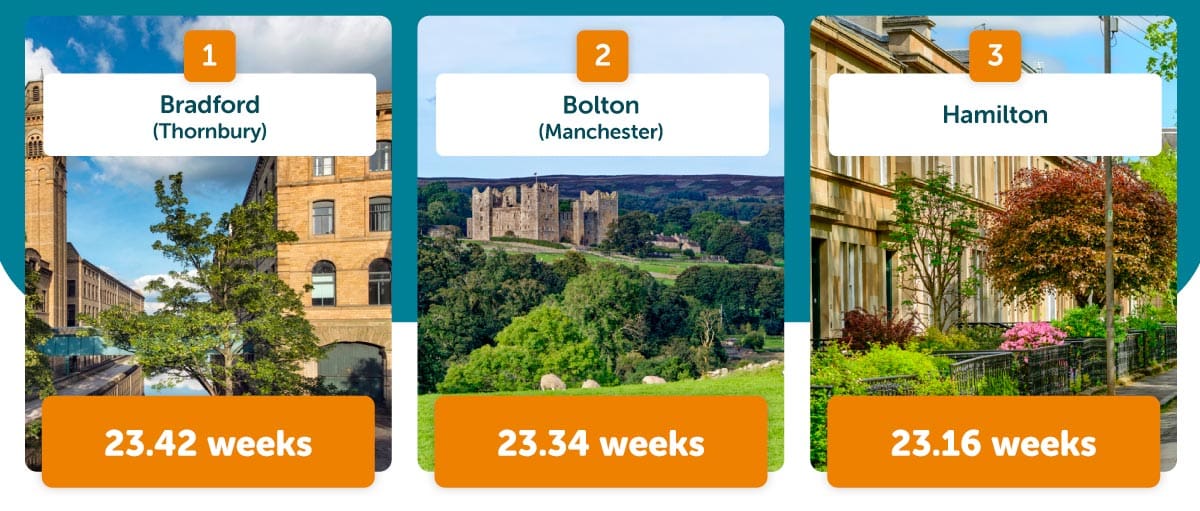
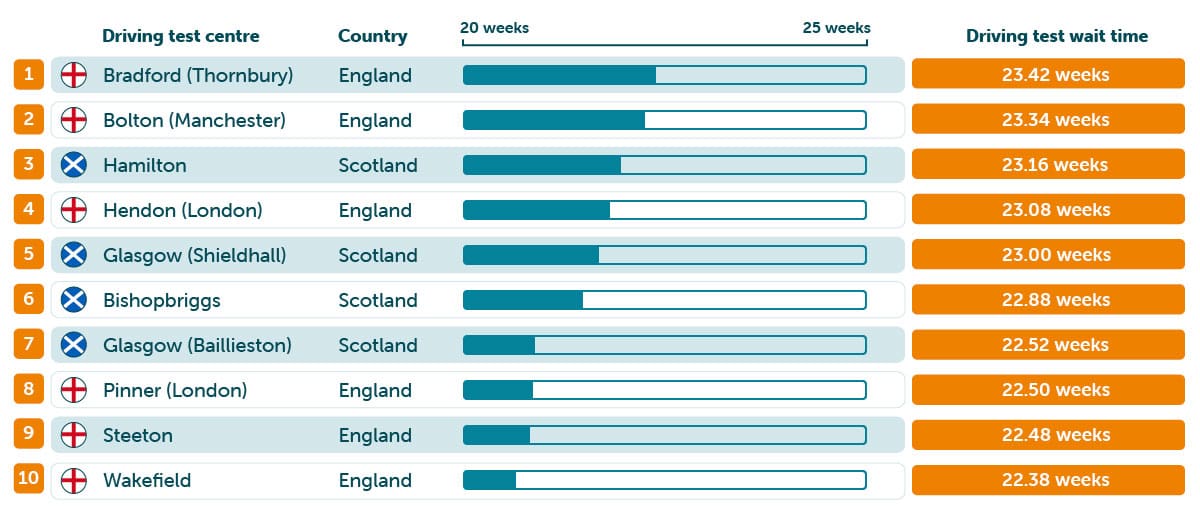
- Bradford (Thornbury): 23.42 weeks average wait time
If you are learning to drive in the Bradford area, specifically in Thornbury, you should expect to be waiting almost 23 and a half weeks between when you book your test and when you eventually get around to taking it.
- Bolton (Manchester): 23.34 weeks average wait time
The Bolton (Manchester) test centre has the second longest waiting time when it comes to taking your driving test. With a more than 23 weeks backlog, anyone looking to take their test here must plan five months in advance, according to the most recent figures.
- Hamilton: 23.16 weeks average wait time
The only test centre outside of England to feature in this top three is Hamilton, which has a waiting time of 23.16 weeks; the third most prolonged delay of any test centre in the UK. Given that Hamilton is among the most populated towns in Scotland, it may come as no surprise that there are lots of people waiting to get on the roads.
Expert tips on how to pass your driving test
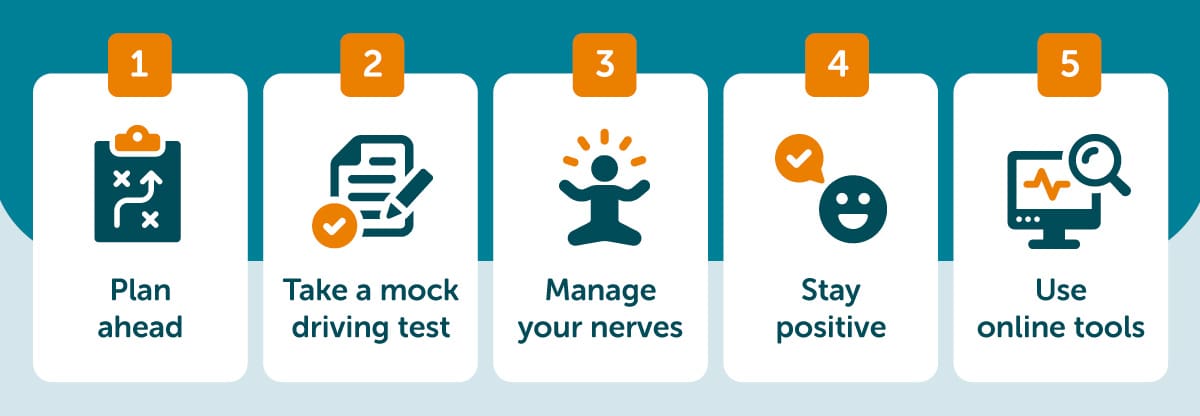
After months, and sometimes years, of driving lessons, your test day is often filled with stress and nerves. Even the most prepared driving students can fall at the last hurdle, but there are things you can do to put yourself in the best position to pass.
Paul Green, National Remarketing Manager at Moneybarn, shares 5 top tips to help you with the big day.


Plan ahead
Despite the long waiting list for practical driving tests, you need to plan ahead if you are looking to pass soon. It can be tempting to pick the nearest date, but you should ensure it doesn’t clash with any stressful events you may have, like an important meeting or school exam, as this could put you in bad position for your test.
Make sure you arrive at the test centre on time and wear appropriate footwear (like flat shoes or trainers).

Take a mock driving test
Whether you’re taking your test for the first time or have experienced the joys of a practical driving test before, you may feel nervous for the unknown for the big day. Mock driving tests allow you to practice in a test-like environment and become familiar with the ins and outs of a test scenario. This will also help you and your instructor identify potential improvement areas.

Manage your nerves
No matter how much you prepare, the test day will always be daunting. While it is difficult to remove the pre-test jitters altogether, there are some things you can do to reduce their effects on your performance. Whether your test slot is in the morning or afternoon, getting an early night is imperative to maximise your chances of getting a good night’s sleep.
If you wake up on the morning of your test and feel like you need more energy, then the best thing to do is stay hydrated and eat slow-burning foods while avoiding caffeine where you can, as this can induce anxiety.

Stay positive
A positive mindset for your practical test is essential to your driving preparations. Although it is much easier said than done, something as simple as visualising all the fun places you can go when you pass your test will help you stay on track and focus on your goal.
Also, you can have up to 15 minors on your practical test, so there is room for a few little mistakes. Having the mindset that you don’t need to be perfect will help you stay calm during your test and reduce some of the pressure you may put on yourself in the lead-up to the big day.

Use online tools
There are lots of free online tools to help with your practical and theory tests. You can take a free mock theory test online, and for your practical, there are extra tips on the GOV.UK website.
Methodology
The data in this study is accurate as of January 2024.
We used GOV.UK to find the following data:
- DRT1101: Change in practical and theory car pass rates between the 2012-13 and 2022-23 financial years. We took the number of tests conducted, the number of passes, and the pass rate (as a percentage).
- DRT0202: Age differences in 1st attempt practical car passes for the 2017-18 financial year (most recent figures). We took the number of tests conducted, the number of tests passed, and the pass rate (as a percentage). We removed the ‘16-year-old’ entry as they had < 50 tests conducted.
We used GOV.UK to find the following data:
- DVSA0201: Number of conducted tests, number of total passes and the pass rate of each UK test centre between April 2023 to September 2023. We removed any test centres with <1000 conducted tests and those with missing data.
- DVSA1202: Number of 1st attempts conducted, number of first-attempt passes, and the first-attempt pass rate of each year between 2012/13 – 2022/23
We used GOV.UK to find the top ten most common driving faults between April 2022 and March 2023.
We used DVSA to find the average wait time (in weeks) of each test centre between April 2022 to March 2023.
We subtracted the 2013-14 value from the 2012-13 value before dividing this by the 2012-13 value and multiplying this by 100 to find the percentage change between these two years. This calculation was used to find the percentage change of each year in the following sections: change in practical and theory pass rates and change in first-attempt pass rates.
As data was collected from 2012/13, this calculation could not be carried out for the 2012/13 figures, resulting in blank spaces on these tables.

Which UK areas are home to the luckiest learner drivers?
There is a lot to think about when it comes to driving, from taking driving lessons to applying for car finance to help with the cost of purchasing your vehicle. Despite having so much to consider, the allure of driving a car makes us eager to get behind the wheel.
Recent figures estimate that more than 1.6 million Brits have taken a practical test in the last financial year alone, but how many of these have resulted in a pass? Using government data, we will reveal where drivers achieved the highest pass rate in the UK and how pass rates have changed over the past decade.
In addition, we’ll look at the age groups with the highest pass rate and the current average wait times to take your driving test across the country. To provide you with all the information you need for the big day, we will also share the most common driving faults before providing some expert tips on how to best prepare for your test.
How has the UK practical pass rate changed in the last decade?
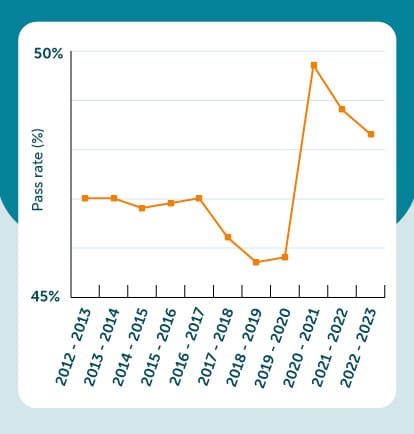
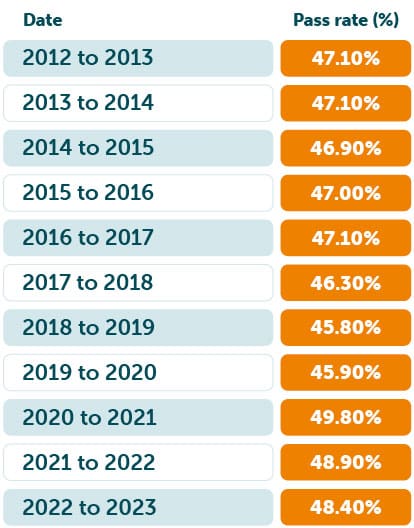
The number of conducted driving tests peaked in the 2016/17 financial year when more than 1.73 million drivers were tested on the roads. However, the highest annual passes occurred in the 2022/23 year, where 816,775 successful practical tests were recorded.
Due to the COVID-19 pandemic and resulting lockdown measures, fewer people took a driving test in 2020/21. Those who did take a test saw a practical pass rate of almost 50% – an 8.50% increase from the previous year and higher than any other pass rate in the last decade.
Since 2020, the pass rate has stayed consistently higher than pre-COVID. However, it is experiencing a slow decline year-on-year, decreasing by -1.02% between 2021/22 and 2022/23.
How has the UK theory pass rate changed in the last decade?
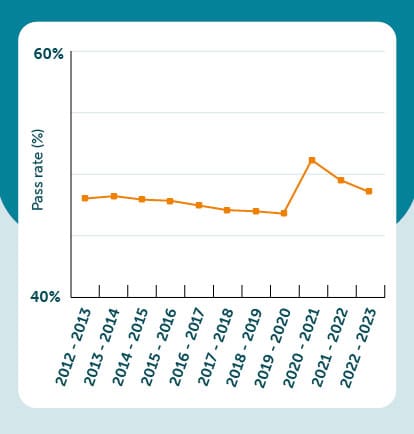
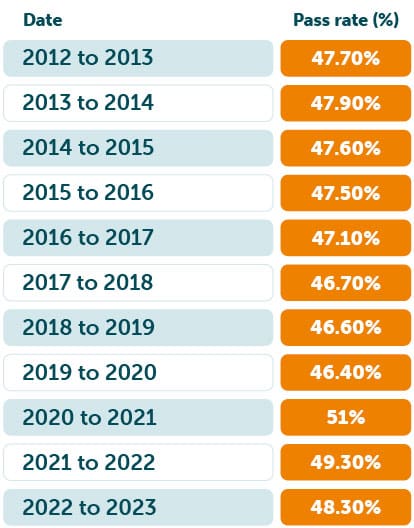
This time 10 years ago, theory test takers had a pass rate of nearly 60%. Fast forward to the 2022/23 financial year, and this number has dropped to 44.20%, a significant decrease in pass rates.
Figures indicate that more UK residents are progressing in their driving than ever, as the number of conducted theory tests has nearly doubled in the last decade – from just over 1.2 million in 2012/13 to more than 2.4 million in the 2022/23 financial year. The theory test pass rate has taken a hit recently, with an 11.78% decrease between 2021/22 and 2022/23.
How has the first-time pass rate changed in the last decade?


Recent years have seen an increase in the quality and quantity of first-time practical driving tests. 2021/22 saw the highest recorded number of first – attempts with one of the highest first-attempt pass rates, totalling 816,122 and 49.3%, respectively.
On the other hand, the lowest performing year in terms of the rate of first-attempt passes was the 2019/20 financial year, which saw a pass rate of just 46.40% out of the 720,490 tests completed – this was 0.21% lower than the previous year.
UK driving test centres with the highest practical pass rate
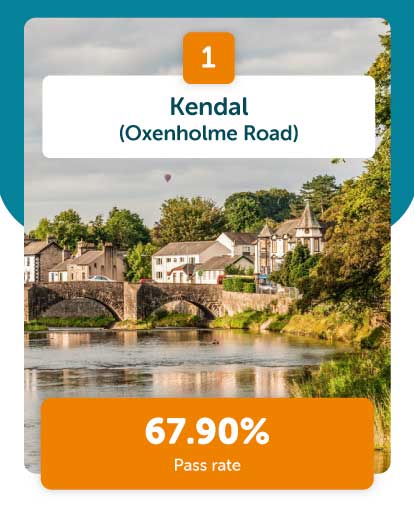
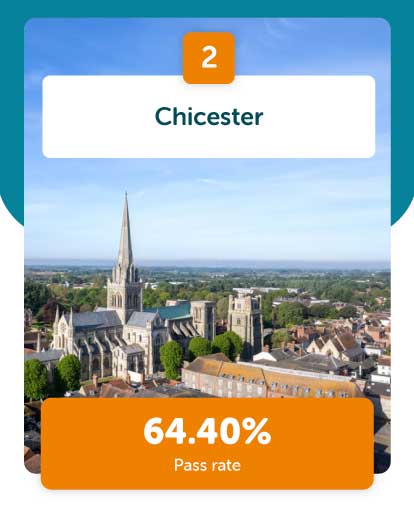
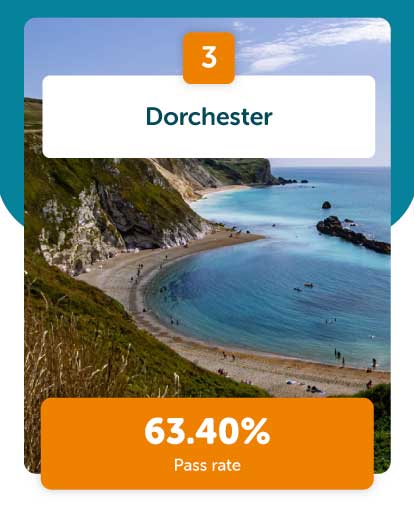
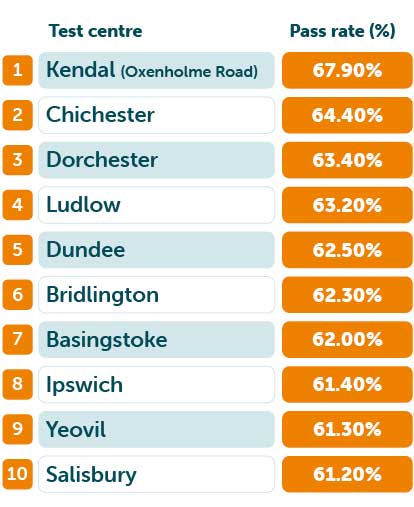
- Kendal (Oxenholme Road): 67.90% pass rate
According to recent data, the Kendal (Oxenholme Road) test centre is the most successful when it comes to passing your practical driving test. Located in Cumbria, this test centre has a pass rate of almost 68%, the highest of any area on our list.
- Chichester: 64.40% pass rate
Boasting a pass rate of 64.4%, Chichester is revealed as having the second-highest practical driving pass rate. Furthermore, this test centre has more passes than any other entry in our top three, totalling 2,361 between April 2023 and September 2023.
- Dorchester: 63.40% pass rate
Trailing just behind Chichester in the ranking is Dorchester. Of the 2,305 tests taken here between April 2023 and September 2023, almost two-thirds have resulted in a pass, which is among the highest pass rates of every test centre on our list.
UK driving test centres with the lowest practical pass rate
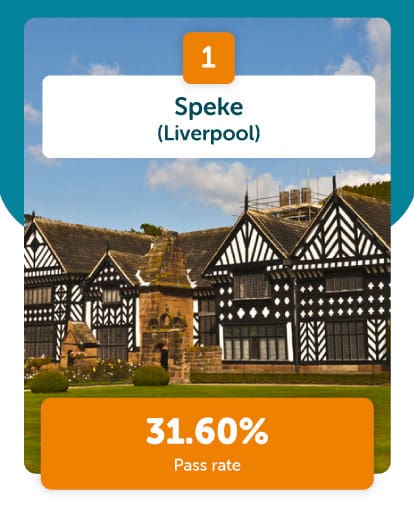
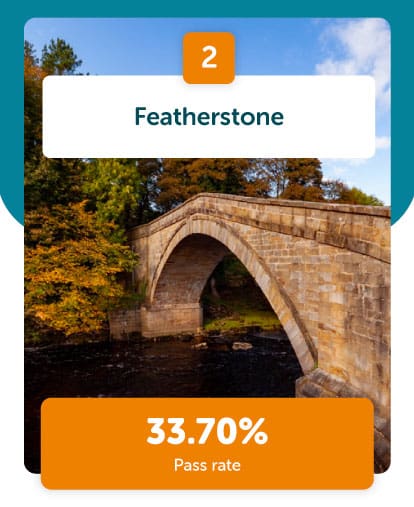
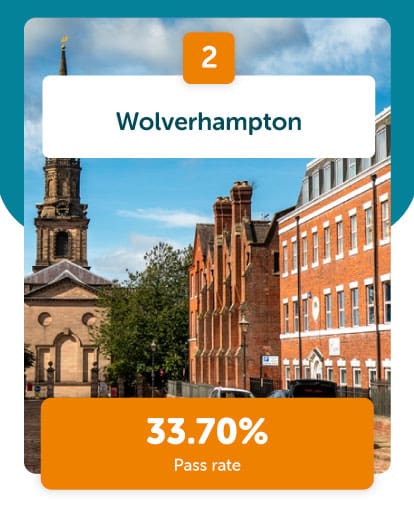
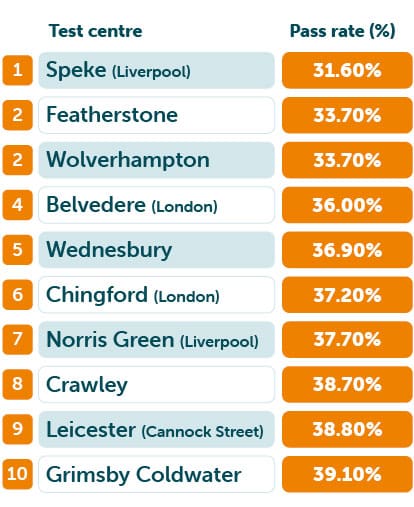
- Speke (Liverpool): 31.60% pass rate
Speke is the closest test centre for those learning to drive in South Liverpool. Unfortunately, this is also home to the lowest practical pass rate, which stands at 31.6% as of September 2023 – this is quite a way off the 48.8% national average.
- Featherstone and Wolverhampton: 33.70% pass rate
Featherstone and Wolverhampton driving test centres have a practical pass rate of 33.7%, the joint second-lowest pass rate of every entry on our list. Featherstone’s test centre has seen nearly 500 fewer passes compared to Wolverhampton.
- Belvedere (London): 36% pass rate
Completing the top three list of UK test centres with the lowest practical driving pass rate is Belvedere (London). London is known for its busy roads all year round, so it may be unsurprising that only 36% of driving tests here have been passed.
Which ages have the highest practical driving pass rate?
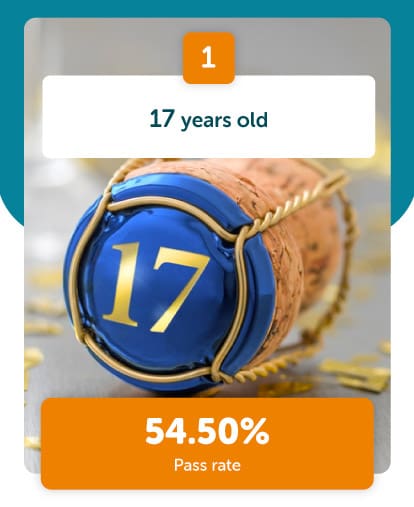
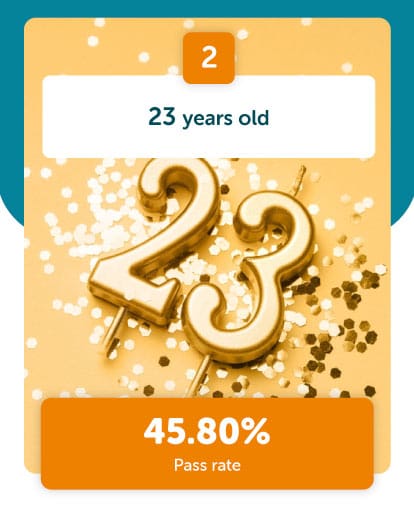
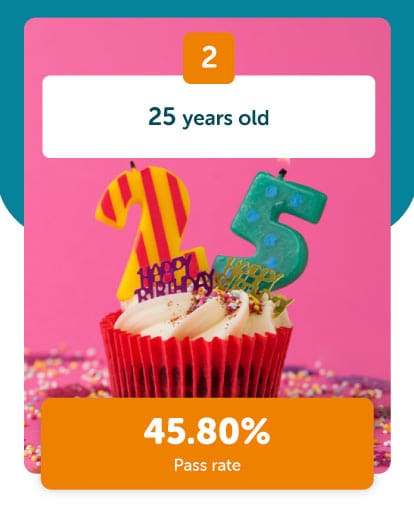
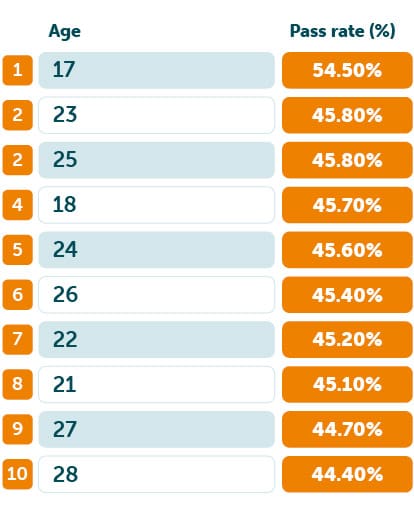
- 17 years old: 54.5% pass rate
In the UK, you can start driving a car at 17, and it is common for many teenagers to start driving lessons as soon as they turn this age. With this in mind, it may come as no surprise that 17-year-olds have the highest number of conducted tests on our list. In addition to this, they also have a better pass rate than any other age group, at 54.5%.
- 23 and 25 years old: 45.8% pass rate
The practical pass rate for both 23-year-olds and 25-year-olds is 45.8%, the joint second-highest of any age. Despite having the same pass rate, these two age groups differ quite a lot in the number of people taking tests, totalling 29,331 and 22,626, respectively.
- 18 years old: 45.7% pass rate
Our study found that 18-year-olds have the third highest practical driving pass rate of any age group, totalling 45.7%. This pass rate is based on the annual total of more than 110,000 tests conducted, in which over 50,000 drivers successfully earned their licence.
What are the most common driving faults?
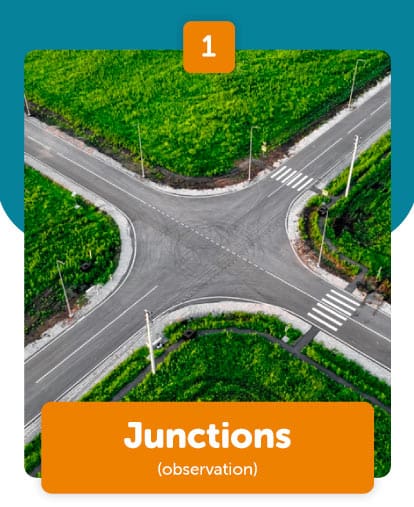
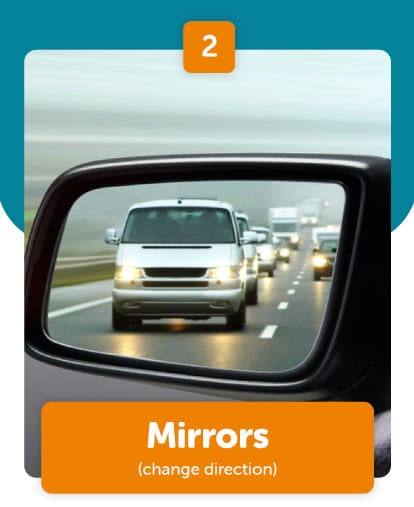
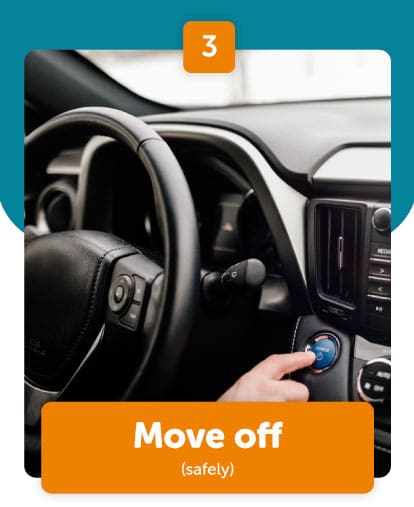
Our study found the top 10 most common driving faults:
- Junctions (observation)
- Mirrors (changing direction)
- Move off (safely)
- Junctions (turning right)
- Control (steering)
- Response to signals (traffic lights)
- Response to signals (traffic signs)
- Positioning (normal driving)
- Response to signals (road markings)
- Reverse park (control)
With so many things to consider during your driving test, it is common for people to make minor mistakes. Of all the possible faults, the most common is inability to make correct observations at junctions. This is followed by a failure to check mirrors when changing direction and moving off safely.
On the other hand, some faults catching people out less frequently include response to signals (road markings) and the ability to control the car during a reverse park.
The UK driving test centres with the longest average wait time
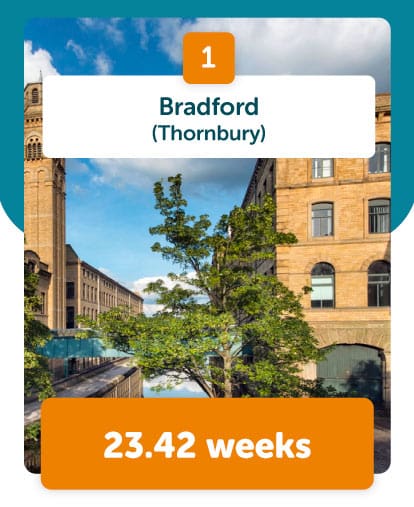
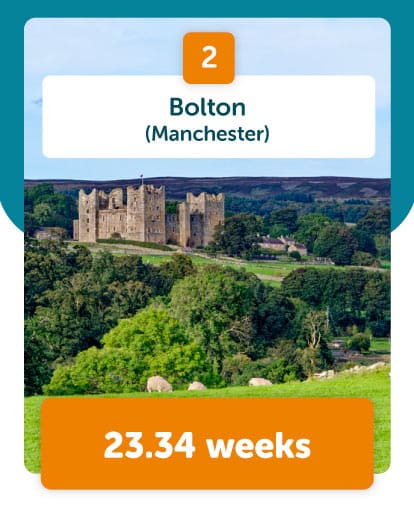
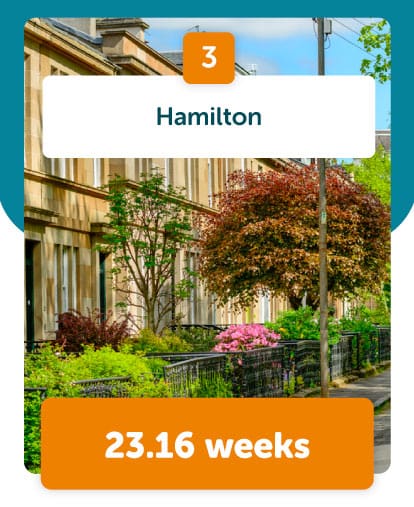
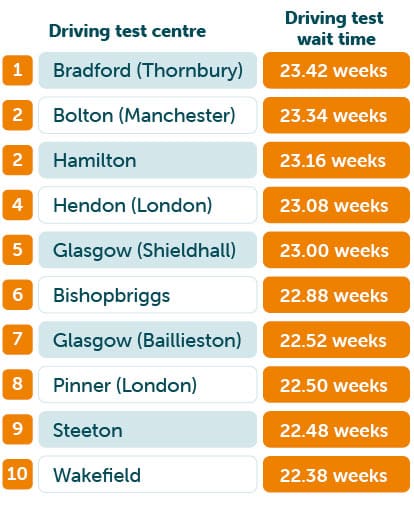
- Bradford (Thornbury): 23.42 weeks average wait time
If you are learning to drive in the Bradford area, specifically in Thornbury, you should expect to be waiting almost 23 and a half weeks between when you book your test and when you eventually get around to taking it.
- Bolton (Manchester): 23.34 weeks average wait time
The Bolton (Manchester) test centre has the second longest waiting time when it comes to taking your driving test. With a more than 23 weeks backlog, anyone looking to take their test here must plan five months in advance, according to the most recent figures.
- Hamilton: 23.16 weeks average wait time
The only test centre outside of England to feature in this top three is Hamilton, which has a waiting time of 23.16 weeks; the third most prolonged delay of any test centre in the UK. Given that Hamilton is among the most populated towns in Scotland, it may come as no surprise that there are lots of people waiting to get on the roads.
Expert tips on how to pass your driving test
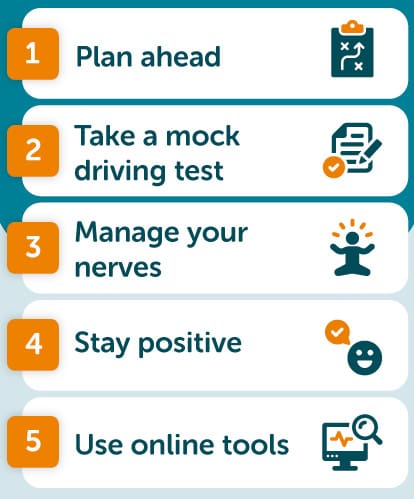

After months, and sometimes years, of driving lessons, your test day is often filled with stress and nerves. Even the most prepared driving students can fall at the last hurdle, but there are things you can do to put yourself in the best position to pass.
Paul Green, National Remarketing Manager at Moneybarn, shares 5 top tips to help you with the big day.

Plan ahead
Despite the long waiting list for practical driving tests, you need to plan ahead if you are looking to pass soon. It can be tempting to pick the nearest date, but you should ensure it doesn’t clash with any stressful events you may have, like an important meeting or school exam, as this could put you in bad position for your test.
Make sure you arrive at the test centre on time and wear appropriate footwear (like flat shoes or trainers).

Take a mock driving test
Whether you’re taking your test for the first time or have experienced the joys of a practical driving test before, you may feel nervous for the unknown for the big day. Mock driving tests allow you to practice in a test-like environment and become familiar with the ins and outs of a test scenario. This will also help you and your instructor identify potential improvement areas.

Manage your nerves
No matter how much you prepare, the test day will always be daunting. While it is difficult to remove the pre-test jitters altogether, there are some things you can do to reduce their effects on your performance. Whether your test slot is in the morning or afternoon, getting an early night is imperative to maximise your chances of getting a good night’s sleep.
If you wake up on the morning of your test and feel like you need more energy, then the best thing to do is stay hydrated and eat slow-burning foods while avoiding caffeine where you can, as this can induce anxiety.

Stay positive
A positive mindset for your practical test is essential to your driving preparations. Although it is much easier said than done, something as simple as visualising all the fun places you can go when you pass your test will help you stay on track and focus on your goal.
Also, you can have up to 15 minors on your practical test, so there is room for a few little mistakes. Having the mindset that you don’t need to be perfect will help you stay calm during your test and reduce some of the pressure you may put on yourself in the lead-up to the big day.

Use online tools
There are lots of free online tools to help with your practical and theory tests. You can take a free mock theory test online, and for your practical, there are extra tips on the GOV.UK website.
Methodology
The data in this study is accurate as of January 2024.
We used GOV.UK to find the following data:
- DRT1101: Change in practical and theory car pass rates between the 2012-13 and 2022-23 financial years. We took the number of tests conducted, the number of passes, and the pass rate (as a percentage).
- DRT0202: Age differences in 1st attempt practical car passes for the 2017-18 financial year (most recent figures). We took the number of tests conducted, the number of tests passed, and the pass rate (as a percentage). We removed the ‘16-year-old’ entry as they had < 50 tests conducted.
We used GOV.UK to find the following data:
- DVSA0201: Number of conducted tests, number of total passes and the pass rate of each UK test centre between April 2023 to September 2023. We removed any test centres with <1000 conducted tests and those with missing data.
- DVSA1202: Number of 1st attempts conducted, number of first-attempt passes, and the first-attempt pass rate of each year between 2012/13 – 2022/23
We used GOV.UK to find the top ten most common driving faults between April 2022 and March 2023.
We used DVSA to find the average wait time (in weeks) of each test centre between April 2022 to March 2023.
We subtracted the 2013-14 value from the 2012-13 value before dividing this by the 2012-13 value and multiplying this by 100 to find the percentage change between these two years. This calculation was used to find the percentage change of each year in the following sections: change in practical and theory pass rates and change in first-attempt pass rates.
As data was collected from 2012/13, this calculation could not be carried out for the 2012/13 figures, resulting in blank spaces on these tables.
Bringing you the latest news and insights from Moneybarn.
More from Moneybarn...
For a better road ahead
Moneybarn is a member of the Finance and Leasing Association, the official trade organisation of the motor finance industry. The FLA promotes best practice in the motor finance industry for lending and leasing to consumers and businesses.
Moneybarn is the trading style of Moneybarn No. 1 Limited, a company registered in England and Wales with company number 04496573, and Moneybarn Limited, a company registered in England and Wales with company number 02766324. The registered address for these companies is: Athena House, Bedford Road, Petersfield, Hampshire, GU32 3LJ.
Moneybarn’s VAT registration number is 180 5559 52.
Moneybarn Limited is authorised and regulated by the Financial Conduct Authority (Financial Services reference No. 702781)
Moneybarn No. 1 Limited is authorised and regulated by the Financial Conduct Authority (Financial Services reference No. 702780)




